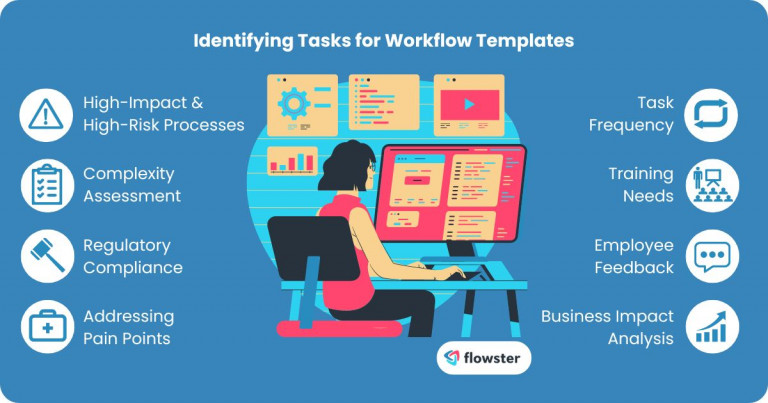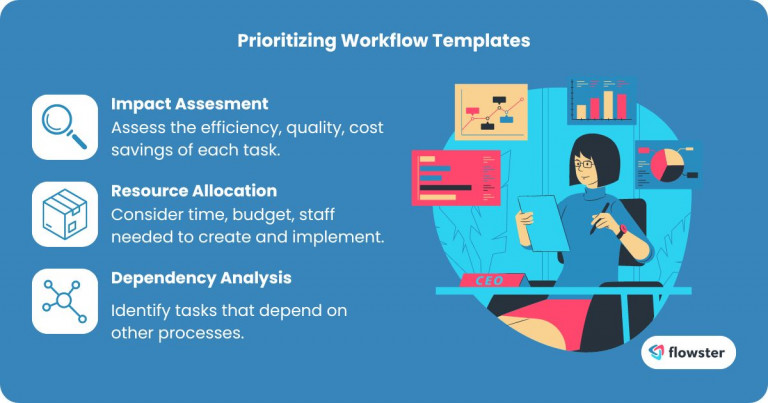Workflow templates are pre-designed blueprints that outline a series of steps to complete a task efficiently. They’re like a GPS for your business processes, guiding employees towards optimal outcomes. By standardizing repetitive tasks, workflow templates significantly boost efficiency, improve quality, and enhance overall organizational performance.
However, not all tasks are equally suited for template creation. Determining which processes to prioritize for workflow templates is crucial. In this post, we’ll explore a strategic approach to identifying the most impactful tasks and outline the steps involved. Let’s dive in.
Article Outline
Identifying Tasks for Workflow Templates
To maximize the benefits of workflow templates, it’s essential to prioritize tasks that will deliver the greatest impact. Let’s explore key criteria for identifying these high-value opportunities.
1. High-Impact & High-Risk Processes
Focusing on tasks that significantly influence productivity, quality, or compliance is paramount. These are the processes that, when streamlined, yield the most substantial improvements. For instance, financial closings, customer onboarding, or product launches often involve multiple steps, numerous stakeholders, and high stakes. Converting these into efficient workflow templates can dramatically reduce errors, improve turnaround times, and mitigate risks.
2. Complexity Assessment
Complex processes with multiple steps or decision points are ideal candidates for workflow templates. By breaking down these intricate tasks into clear, sequential steps, you simplify execution and minimize errors. Consider processes like IT incident resolution, procurement approvals, or project planning. Transforming these into templates can dramatically reduce training time and improve consistency.
3. Regulatory Compliance
Ensuring adherence to industry regulations and standards is crucial. Workflow templates embedded with Standard Operating Procedures (SOPs) can serve as a powerful compliance tool. By standardizing processes, you reduce the risk of human error and the potential for costly legal consequences. Areas like data privacy, healthcare, or financial services often have strict compliance requirements that can be effectively managed through workflow templates.
4. Addressing Pain Points
Workflow templates are a potent weapon against recurring problems and bottlenecks. Identifying tasks that consistently cause delays, frustrations, or quality issues is essential. For example, invoice processing, customer support escalations, or supply chain disruptions might benefit significantly from template-driven standardization. By eliminating these pain points, you improve employee satisfaction, enhance customer experience, and boost overall operational efficiency.

5. Task Frequency
High-volume tasks performed repeatedly or by multiple teams are prime candidates for workflow templates. Standardizing these processes can dramatically boost productivity and consistency. Consider tasks like expense reports, customer service inquiries, or sales order processing. By creating efficient workflow templates for these high-frequency activities, you can free up employee time for more strategic work.
6. Training Needs
Workflow templates excel at streamlining training and onboarding processes, especially for complex tasks. By providing clear, step-by-step guidance, templates ensure consistency and reduce the learning curve. Processes like new hire orientation, equipment maintenance, or project initiation can benefit significantly from template-based training.
7. Employee Feedback
Frontline employees often have invaluable insights into the most challenging and time-consuming processes. Soliciting their input can help identify hidden opportunities for workflow template creation. By addressing their pain points, you boost employee morale and productivity. Consider conducting surveys, interviews, or focus groups to gather employee feedback on process improvement.
8. Business Impact Analysis
Evaluating the potential impact of standardized processes on key business metrics is crucial. Consider how workflow templates can affect customer satisfaction, revenue, operational costs, or employee turnover. By focusing on tasks that drive the most significant improvements in these areas, you can maximize the return on your workflow template investment.
By carefully considering these factors, you can identify a prioritized list of tasks ripe for workflow template creation. Let’s move on to the next step: prioritizing these tasks and taking action.

Workflow Templates Prioritization and Next Steps
After identifying potential tasks for workflow templates, it’s time to prioritize them based on their impact and feasibility. Consider starting with high-impact, low-complexity processes to achieve quick wins and build momentum.
Prioritization
- Impact Assessment: Evaluate the potential benefits of each identified task in terms of efficiency, quality, and cost reduction.
- Resource Allocation: Consider the time, budget, and personnel required to create and implement each workflow template.
- Dependency Analysis: Identify tasks that rely on other processes to determine the optimal implementation sequence.
Next Steps
Once prioritized, begin developing your first workflow templates. Remember, the goal is to create reusable, scalable solutions. Start small, gather feedback, and refine your templates over time.
To jumpstart your workflow template journey, consider exploring our Flowster Marketplace for free templates and SOP examples. Additionally, our “Done-for-You” services can provide expert guidance and support.
By following these steps and leveraging available resources, you can effectively implement workflow templates to drive organizational success.
Let’s wrap up by summarizing the key benefits of a strategic approach to workflow templates.
Flowster's AI-Driven Automation
Conclusion: Unlock Your Organization’s Potential with Workflow Templates
By strategically prioritizing tasks for workflow template creation, you can unlock significant efficiency gains, improve quality, and enhance overall organizational performance. Remember to focus on high-impact, complex, and frequently performed processes while considering employee feedback and business impact.
Start small, iterate, and measure the results. With the right approach, workflow templates can become a powerful tool for driving success and achieving your business objectives.
Ready to streamline your operations? Explore Flowster for free workflow templates and SOP examples.




